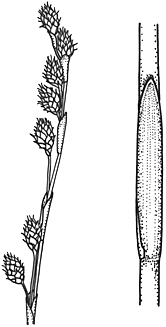Baloskion longipes (L.A.S.Johnson & O.D.Evans) B.G.Briggs & L.A.S.Johnson APNI* Synonyms: Restio longipes L.A.S.Johnson & O.D.Evans APNI*

Description: Dioecious perennial herb, tufted or rhizome shortly creeping.
Cauline sheaths usually with few very short hairs on margins. Culms erect, c. 90–150 cm high, 2–2.5 mm diam. Sheaths closely appressed, c. 20–30 mm long, apex acute; lamina absent.
Spikelets on the lower part of the inflorescence not crowded, but borne on filiform pedicels or fine branches, either of which may be several cm long. Apex of the subtending bracts closely appressed. Flowering glumes 4–6 mm long. Spikelets 6–25, on filiform pedicels up to 60 mm long, arranged in a loose raceme or narrow panicle up to 25 cm long, many-flowered. Flowering glumes with apex caudate to cuspidate. Male spikelets ovate, 4–8 mm long. Male tepals 6; stamens 3; pistillode minute. Female spikelets ovate to elliptic, 8.5–9.3 mm long. Female tepals 4; staminodes 2.
Distribution and occurrence: in swamps or depressions in alluvium; in Clyde Mtn district.
NSW subdivisions: CT, ST
Threatened species: NSW BCA: Vulnerable; Commonwealth EPBC: Vulnerable
Text by A. L. Quirico & B. G. Briggs (1993)
Taxon concept: Flora of NSW 4 (1993) (as Restio longipes)
APNI* Provides a link to the Australian Plant Name Index (hosted by the Australian National Botanic Gardens) for comprehensive bibliographic data
***The AVH map option provides a detailed interactive Australia wide distribution map drawn from collections held by all major Australian herbaria participating in the Australian Virtual Herbarium project.
|


